Thursday, 25 May 2023
Thursday, 18 May 2023
Friday, 12 May 2023
Archaeology: Roman temple discovered in Brittany, France thought to be dedicated to Mars could have been used to worship many gods
 |
| An artist's depiction of the temple at La Chapelle-des-Fougeretz as it would have looked in the first century AD. Marie Millet INRAP |
 |
| Archaeologists from the French research institute INRAP at the site in Brittany. Photograph: Bastien Simier |
They speculated that it had probably been used by Roman soldiers for hundreds of years to pay homage to Mars, the god of war.
It was the discovery of a fine bronze statuette of Mars that suggested the temple may have been a shrine to the god. But the site also had clay figurines of Venus and the mother goddesses, leading to uncertainty about which deity was worshipped there.
Two buildings were at the core of the site – a square within a square, one slightly smaller than the other. This design is typical of Romano-Celtic temples (found in modern France, parts of Belgium, Germany, Switzerland and the north-west provinces of the Roman Empire).
Scholars of ancient religion in the Celtic north west regions of the Roman Empire (of which ancient France was a major part) used to regard a double temple arrangement as a dedication to a divine pair, one male and the other female, such as Apollo and Sirona or Mercury and Rosmerta.
 |
Excavation at the temple site in France. Emmanuelle Collado/INRAP |
But this theorising was a reflection of 19th and 20th century colonial thinking. Present day experts have found that ancient people chose their forms of worship, rather than having religions imposed upon them.
Ancient communities could preserve Iron Age traditions or adopt aspects of Roman classical religion. This is reflected in the archaeology of their temple sites.
Some had wooden buildings and few, if any, featured classical images of gods. Others, particularly in the towns, opted for a more full on Roman style of worship, even if the old native traditions still underpinned the rituals.
How the gods were worshipped at these temples
Looking at excavations of temples in Gaul (modern France, with parts of Belgium, Germany and Switzerland) and Britain, it is striking that the architectural form is often quite standardised.
The temples are usually in the Romano-Celtic design, with a small square central tower surrounded by a portico (a row of evenly spaced columns with a lean-to roof up against the central tower).
The sculpture, inscriptions, artefacts and sacrificial remains are, however, widely variable. They reveal the development of a highly localised suite of ritual activities that varied significantly from one temple to another.
Equally striking is their long-term stability. It seems that once established (either in the early Roman period or sometimes in the pre-conquest late Iron Age), rituals quickly settled down into patterns that continued, at some sites, for centuries.
 |
The bronze figurine of the Roman god Mars found at the temple. Emmanuelle Collado/INRAP |
Mars, Venus and the mother goddesses (and possibly others not yet discovered) were probably the deities included in the rituals observed in the two shrines and the equally important open air courtyard in which the shrines stood.
It is in the courtyard that much of the public ritual, such as sacrifices, would have taken place. From this perspective, archaeologists cannot be sure that, for instance, the bigger temple was for Mars and the smaller one for the female deities. We do not know the exact purpose of the temple buildings themselves. The central cella area is usually thought to be a “house for the god”. Plinths are sometimes found within them, suitable for a statue or other cult idol.
The surrounding porticoes are secondary features, as some temples start life as a simple square structure and the portico is added later. At the site of Pesch, near Aachen in Germany, the portico of one of the two temples had altars to the Matronae goddesses (a variant on the mother goddesses). The cella, meanwhile, contained a statue of Jupiter.
It looks as though the porticoes developed as a shelter for votive offerings, up against the central shrine building.
Many gods in the sacred landscape
At many temples, a wide variety of images and god names have been found.
At Gerolstein, near Trier in Germany, there was Minerva, Venus, Mercury, Bacchus and Hercules. At Le Hérapel in the Moselle region of France, there was Sol, Luna, Mercury, Bacchus, Hercules and Epona. At the Bregenz temple site in Austria, there is an inscription to “the gods and goddesses”, showing that many deities were worshipped collectively.
In Britain, the temple at Lamyatt Beacon, Somerset, had a cache of statuettes of Jupiter, Mercury, Mars, Minerva, Hercules and a Genius. Similar hoards of figurines have been found elsewhere in the province.
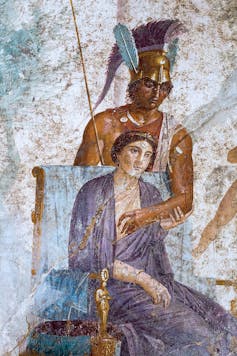 |
Mars and Venus in a wall painting from Pompeii. ArchaiOptix CC BY |
The broader sacred landscape adds clarity to the finds at La Chapelle-des-Fougeretz. The site is complemented by another temple at Mordelles, to the west. Both were within easy reach of the Roman city of Rennes and it is quite possible that they were linked to the town by processional or pilgrimage routes.
In the heart of Rennes itself, evidence for worship of Mars is strong. All three places may have formed the sacred landscape of the citizens, in the form of processions and seasonal festivities.
It is tempting to think of ancient religion in monotheistic terms – one temple, with one god. But the evidence from the Romano-Celtic regions of the empire suggests otherwise. It is much more genuinely polytheistic. Several deities were worshiped at most temple sites, with strong regional networks linking many gods and goddesses together.![]()
Tony King, Professor of Roman Archaeology, University of Winchester
This article is republished from The Conversation under a Creative Commons license.
Subscribe to support our independent and original journalism, photography, artwork and film.
Tuesday, 2 May 2023
Remembering Barry Humphries, the man who enriched the culture, reimagined the one man show and upended the cultural cringe
 |
| Barry Humphries painted by David Hockney at his studio on Mulholland Drive in Los Angeles in 2015. Courtesy David Hockney. Photograph: Jean-Pierre Goncalves de Lima |
By Anne Pender, University of Adelaide
 |
| Barry Humphries in London in 1965. |
Years later, academic Peter Conrad accurately described Humphries’ adolescence as a “one man modern movement”.
The young man secured his first paid acting role after a number of complaints from various women about a Dadaist event called Call Me Madman!, staged at the University of Melbourne’s Union Theatre in 1953. It was anarchic, just like the early Dada shows of the Cabaret Voltaire in Zurich several decades earlier.
Call Me Madman! opened with a single musical phrase played on a violin over and over again, then a pianist sitting out of view of the audience sounded the same chords and notes in repetition, and ended in a ferocious food fight, with Humphries hiding in a cupboard from the outraged students who stormed the stage.
This parody taught him how to provoke his audience, securing their complicit and violent participation in his act. It also gave him his first taste of the power of an audience to determine what happens in the theatre. It was both risky and intoxicating.
When John Sumner, founder of the burgeoning Union Theatre Repertory Company (which would go on to become Melbourne Theatre Company), heard the complaints about the revue, he offered the young man a job.
The birth of Edna
On a tour of country Victoria with the company, Humphries performed a spidery Orsino in Twelfth Night, directed by Ray Lawler with Zoe Caldwell as Viola.
Humphries entertained the cast on the long bus rides, with falsetto speeches in cruel but hilarious parody of the predictable words of thanks given in every town by ladies of the Country Women’s Association over tea. The character invented to pass the time on the bus made her debut in Lawler’s Christmas revue in 1955.
Edna was a composite portrait of various women whose mannerisms had imprinted themselves in his brain as a boy, growing up in staid Camberwell.
With his new character, Humphries summoned a whole new world to the stage and created a comedy of ordinariness that had never been presented before.
This Mrs Average took on a life of her own and shone as the centrepiece of Humphries’ theatrical world for the next 60 years, becoming Dame Edna Everage – elevated by the Prime Minister Gough Whitlam himself – in Barry McKenzie Holds His Own in 1974.
Just two years later, Humphries’ extravaganza Housewife Superstar! charmed the West End. Wearing a massive hat sculpted to resemble the Sydney Opera House, Edna stopped the crowds at Royal Ascot that year.
The image of her in that sumptuous creation (now in the Victoria and Albert Museum) launched Edna and Humphries around the world.
Conquering the world
Edna hosted a series of chat shows on British television, watched every week by an audience of eight million. She skewered dozens of politicians, pop stars, singers and actors who graced the program every week.
Her appearance with Jerry Hall singing Stand by your Man remains one of the most hilarious television moments of that time.
Humphries’ success on British television in the 1980s and 1990s were among the major achievements of his career. He created his very own theatre of the absurd with his reinvention of the chat show. The me-generation could not get enough.
After that, Edna conquered Broadway.
Humphries’ theatrical magic also included dozens of other characters, all of them parodic and sharply satirical, such as the hard-drinking diplomat Sir Les Patterson.
He delighted audiences and prosecuted his satirical attacks on Australian life. On stage and on television, his ingenuity as a performer derived from his instinct for improvisation. At his best, the audience was treated to exceptional satirical theatre.
The early years
John Barry Humphries was born February 17 1934, the oldest child of Eric and Louisa Humphries. Eric ran a flourishing building business (he might be called a developer nowadays) and Louisa was a homemaker. As a child, Barry was close to his sister, Barbara. Barry also enjoyed adult company. He loved dressing up and accompanying his mother on trips to the city or out for lunch with other ladies.
At Melbourne Grammar, Humphries found the boys who excelled in sports rewarded and praised for their achievements. Everyone else was a second-class citizen. An interest in art or music was considered by the headmaster to be suspicious, a disappointment for Humphries, passionate about art.
In time, Humphries found a way to survive Melbourne Grammar – through provocation. When he was reprimanded for failing to cut his hair to regulation length, he stared coolly at the headmaster and said, “There’s one man in the chapel with hair that is longer than mine. His name is Jesus”.
Humphries’ comment was not punished. Before long everyone had heard of his audacious retort.
On icy winter afternoons at the MCG – compelled to watch the titans of the school wrestle in the mud – Humphries found an ingenious way of expressing his view of proceedings. He positioned himself in a chair with his back to the football field, facing the spectators.
Slowly he drew out of his specially made Gladstone bag a set of large knitting needles and ball of wool; he would sit for the duration of the match calmly knitting a cardigan.
A transformational artist
Humphries was resilient and indomitable. He defeated alcoholism. He was generous, competitive and single minded.
With his mask off he was as witty as when he wore it. He married four times and raised two daughters and two sons.
He is survived by his wife Lizzie Spender, and children Tessa, Emily, Oscar and Rupert.
Humphries transformed Australian comedy, bringing an astringent and anarchic Australian theatre to the world. Manning Clark called him one of the “mythmakers and prophets of Australia […] enriching the culture which had been dominated by the straiteners”.
He certainly enriched the culture, reimagined the one man show and upended the cultural cringe. Bravo Barry. Farewell.![]()
Anne Pender, Kidman Chair in Australian Studies and Director, JM Coetzee Centre for Creative Practice, University of Adelaide
This article is republished from The Conversation under a Creative Commons license.
Subscribe to support our independent and original journalism, photography, artwork and film.
Thursday, 20 April 2023
Highlights of Milan Design Week: Qeeboo's New Collection by Stefano Giovannoni, Philippe Starck, Nika Zupac and Studio Campana
 |
| The new coat stand, Saguaro, shaped like a cactus and designed by Stefano Giovanonni. part of his company's new collection launched in Milan. |
Italian brand Qeeboo's latest collection features collaborations with renowned designers including Philippe Starck and Studio Campana, and founder, Stefano Giovannoni. Launched at Milan Design Week, the new works redefine the concept of tableware and the dreamy animal-sculptures have a strong expressive identity, writes Antonio Visconti
 |
Philippe Starck's HelfYourself table, designed. for the new Qeeboo collection in Milan. |
Qeeboo's innovative designs have a twist of pop culture and a quirky individuality combined with attention to detail and high-quality production.
This year, the company has launched a partnership with star designer Philippe Starck. The new works are called HelpYourself, and are made up of a collection of figurative tables (see above).
“The HelpYourselfs is a family of charming geniuses who watch over the happiness of the house by carrying the tables,” says Philippe Starck. Three legs and three arms are the base for two tabletops of different dimensions and materials. The bigger one (a dining table) holds a glass top while the smaller one (a sidetable) is moulded in one piece with a polyethylene surface.
Italian design brand, Qeeboo was founded in Milan by Stefano Giovannoni in 2016 with the aim of producing designs that stimulate self-expression and creativity
 |
The Brazilian Studio Campana's new Bacana chair, with its intricate, fluid design. |
The Bacana chair is the first Campana project industrially developed, using 100% recyclable polypropylene, known for its durability and resistance.
The winding curves and tangled knots of plastic represent the designers' way of communicating, their own language of forms. In Portuguese slang bacana means “cool”, and it sums up the Campana’s aesthetic. The new chair uses minimum quantities of material, establishing a new standard for sustainable design and mass production.
The exciting collaboration with Studio Campana, produced the Bacana chair, establishing a new standard for sustainable design and mass production
 |
Stefano Giovannoni's bookcase inspired by hollowed-out stones can be upright either horizonally or vertically. |
The bookcase can be standing either horizontally or vertically in any space you wish, in an office or home, and either stand alone to divide spaces or against the wall.
Made in recyclable polyethylene and available in different colors, the library can be combined with additional units.
Saguaro, a coat stand in the shape of a cactus typical of the Sonoran Desert, is also a part of the new collection (see main picture above).
The cactus grows different branches as it ages and this inspired the tall stand, also designed by Stefano Giovannoni, for coats, hats and jackets. It comes in a variety of colours and is made in recyclable polyethylene and supported by a metal lacquered base: it would make a dramatic and eye-catching statement in any room.
“The HelpYourselfs is a family of charming geniuses who watch over the happiness of the house by carrying the tables,” says Philippe Starck
 |
Elisa Giovannoni's Cobble table and chairs that has central insert for a pot plant or for ice and bottles. |
Kris Ruhs, an artist, joins Qeeboo's creative team and presents Kritters, a collection of animal-sculptures with a strong expressive identity.
He designed the three ceramic vases in black and white.
These represent different animals: a cat named Dalila, a dog named Bozo and an owl named Spike.
Elisa Giovannoni's Cobble table features a square top and a central insert that can be used to contain plants or bottles
 |
The new Hungry Frog lamp launched in Milan and designed by Marcantonio. |
"A collection that pays homage to the monsters, creatures and all the different beings that make this world so colorful and wonderful," says Oggian.
In addition, Qeeboo is renewing collaborations with some familiar names, including Marcantonio, who presents Hungry Frog, a frog that eats a light bulb (see image at left),
"A collection that pays homage to the monsters, creatures and all the different beings that make this world so colorful and wonderful," says Oggian.
 |
Dai Sugasawa's quirky fish-shaped table lamp, that is inspired by creatures in the deep sea with their own internal "lights". |
Dai Sugasawa's Abyss fish-shaped table lamp is inspired by the anglerfish swimming in the deep seas (see picture at right).
The anglerfish are quite a bony fish (and not as cuddly looking as Sugasawa's design) with a luminescent fin ray that acts as a lure for other fish.
The rather lovable, rounded graphic lamp is designed in different colours and can be used at home, at the studio or the office and makes a singular talking point.
All of these designs are exhibited at the Qeeboo flagship Store in Via Crocefisso 27, Milan.
Subscribe to support our independent and original journalism, photography, artwork and film.
Wednesday, 12 April 2023
The Rossettis: Romantic Revolutionaries of the Art World
_Tate%5B1%5D.jpg) |
| One of the richly atmospheric works at the Rossetti exhibition: Dante Gabriel Rossetti, Mona Vanna, (1866) copyright Tate. |
Enter the world of the Rossettis, a family of rebels who challenged Victorian society with their radical approaches to art, love, and life. Dante Gabriel, Christina, and Elizabeth were pioneers of the Pre-Raphaelite and Aesthetic movements. London's Tate Britain has a new exhibition of paintings and drawings of all three siblings, writes Isabella Lancellotti
_Tate%5B1%5D.jpg) |
| The romanticism of Dante Gabriel Rossetti's Proserpine, (1874). Copyright: Tate |
Their lives and works were marked by a progressive counterculture, blending past and present to reinvent art and life for a fast-changing modern world.
Tate Britain showcases their creativity and innovation through over 150 paintings and drawings, photography, design, poetry, and more.
The exhibition begins with a celebration of the Rossetti siblings' precocious talent, revealing the early sparks of creativity that would mark their careers.
Christina's first edition of poems, published when she was 16, and Dante Gabriel's Ecce Ancilla Domine (The Annunciation) 1850, are the opening pieces, surrounded by an audio installation of Christina's poetry and examples of Dante Gabriel's teenage drawings. These works reflect their early skill and enthusiasm for original voices like William Blake and Edgar Allan Poe.
As visitors move through the exhibition, they are taken on a journey of the Rossettis’ artistic evolution, from the Pre-Raphaelite years to the imaginative and expressive Aesthetic style.
Their lives and works were marked by a progressive counterculture, blending past and present to reinvent art and life for a modern world.
_Guildhall_Art_Gallery%5B1%5D.jpg) |
Dante Gabriel Rossetti, La Ghirlandata, (1874). Copyright: Guildhall Art Gallery |
More personal forms of revolution are explored through the Rossettis' refusal to abide by the constraints of Victorian society. Works such as Dante Gabriel's Found (begun 1854), Elizabeth Siddal's Lady Clare (1857), and Christina's poem The Goblin Market (1859) show how they questioned love in an unequal and materialist world.
One of the highlights of the exhibition is Elizabeth Siddal's surviving watercolours, displayed in a two-way dialogue with contemporary works by Dante Gabriel, exploring modern love in jewel-like medieval settings.
As a working-class artist who was largely self-taught, Elizabeth's work was highly original and inventive, but has often been overshadowed by her mythologization as a tragic muse. Her and Dante Gabriel's work together mark the turning point from Pre-Raphaelitism to the imaginative and expressive Aesthetic style.
The exhibition also takes a fresh look at the unconventional relationships between Dante Gabriel, Elizabeth Siddal, Fanny Cornforth, and Jane Morris. The Aesthetic portraits from the later part of Dante Gabriel's career, such as Bocca Baciata (1859), Beata Beatrix (c.1864-70), and The Beloved (1865-73), are shown in the context of the achievements and experiences of the working women who inspired them.
Works from the Pre-Raphaelite years demonstrate how the spirit of popular revolution inspired these artists to initiate the first British avant-garde movement.
_Private_Collection%5B1%5D.jpg) |
Dante Gabriel Rossetti, Venus Verticordia, (1878). Copyright: Private Collection |
Alongside art and poetry, visitors can experience how the Rossettis' trailblazing new lifestyles transformed the domestic interior through contemporary furniture, clothing, and design.
The exhibition concludes by showing how the Rossettis inspired the next generation, including William Michael's teenaged children who ran the anarchist magazine The Torch, and how they continue to influence radical art and culture to this day.
This exhibition is not just a retrospective of the Rossetti family's work but also a celebration of their revolutionary approach to life, love, and art. It showcases the interconnectedness of their works, their influence on each other, and their legacy in the art world. The Rossettis were true visionaries, pushing the boundaries of art and society, and this exhibition evokes their creativity and innovation.
The Rossettis, 6 April – 24 September 2023, Tate Britain, Millbank, London SW1P 4RG.Open daily 10.00–18.00.
Subscribe to support our independent and original journalism, photography, artwork and film.
Thursday, 30 March 2023
Melbourne Now: A Vast, Sprawling and Inspiring Exhibition that Seems to Burst out of its Architectural Framework
Review: Melbourne Now, National Gallery of Victoria.
Melbourne Now 2013 is still spoken about with reverence.
It was a memorable exhibition: a shot of Viagra to the exhibiting of contemporary Australian art by a public art gallery. It was immense, occupying both buildings of the National Gallery of Victoria and surrounds, and it brought to the fore much art that had never been seen before, combined with some well-known artists still making interesting work.
Melbourne Now 2023 is a more targeted exhibition, confined to the Federation Square building, with roughly half the number of exhibitors compared with its predecessor a decade earlier.
The show does combine the work of some well-established artists, including Shaun Gladwell, Christian Thompson, Katherine Hattam and Julia Ciccarone, with a splurge of fresh blood, names largely unknown outside a tight circle within the arts community.
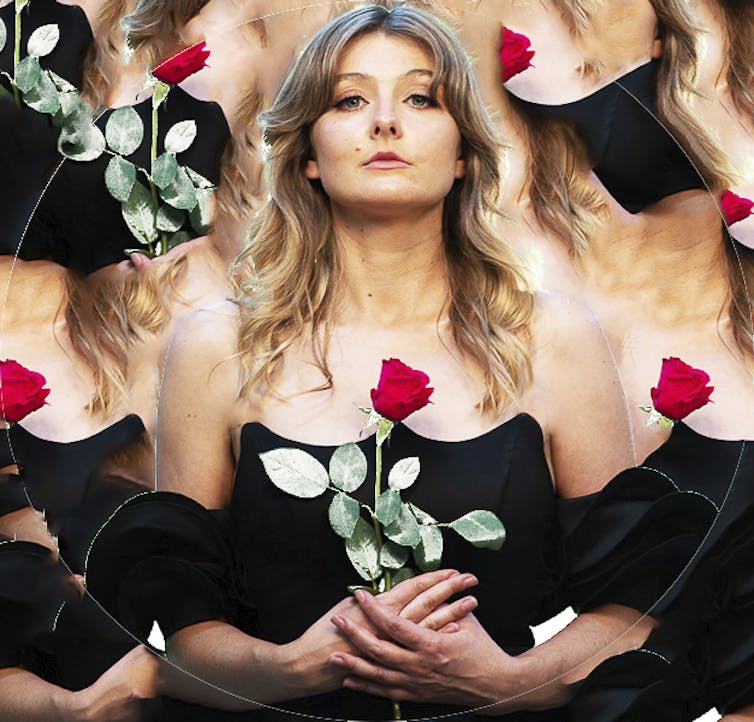
Art is treated within a broad spectrum of the cultural landscape to include not only painters, printmakers, sculptors, photographers, filmmakers and installation artists, but also designers, studios, firms, practising architects, ceramicists, video artists and those working in virtual reality, jewellery, performance, product design and publishing.
These are some of the people who now, or in the near future, will design the way our world looks, feels and operates.
In a vast, sprawling and inspiring exhibition that seems to burst out of its architectural framework, it is pointless to debate omissions in the selection of artists when we are surrounded by so much vital and interesting art that challenges us on so many levels.
Intense visual excitement
Many of the artists are making their NGV debut. This is not a “stable” of artists that has been fostered by a gallery, an accusation that has been levelled, with some justification, at several state galleries.
Many of these artists are not new to the institutional exhibiting scene and may have been seen in some regional galleries, public art spaces and dedicated municipal art centres, but they are new to the NGV and the broader public.
There is a sustained and intense visual excitement that pervades all levels of The Ian Potter Centre: NGV Australia.
We move from Rel Pham’s huge shrine-like “temple” in a darkened room, accompanied by a chorus of 640 computer fans with their cyberspace breeze, to Jenna Lee’s illuminated lanterns in forms reminiscent of traditional Gulumerridjin (Larrakia) dilly bags, and Troy Emery’s quirky nearly three-metre-long textile sculpture, Mountain climber, ready to pounce on the viewer.
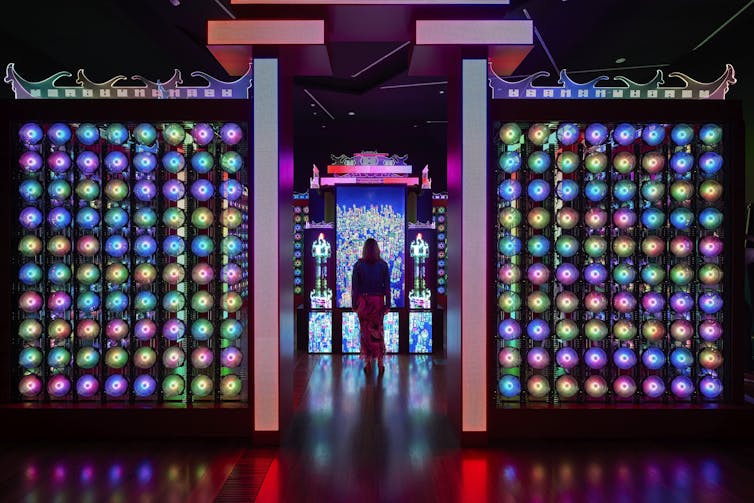
Although each of these works is spectacular and packs a considerable wow factor, they cannot be dismissed as purely hedonistic eye candy designed as an escapist parachute out of reality.
Pham questions the ecological sustainability in our reliance on technology with the colours of the neon illumination chosen for symbolic considerations in Asian cultures. He creates an environment where the physical and digital worlds blur.
Lee, a Larrakia, Wardaman and Karajarri artist, views her lanterns as illuminating her ancestry and its mystical complexities.
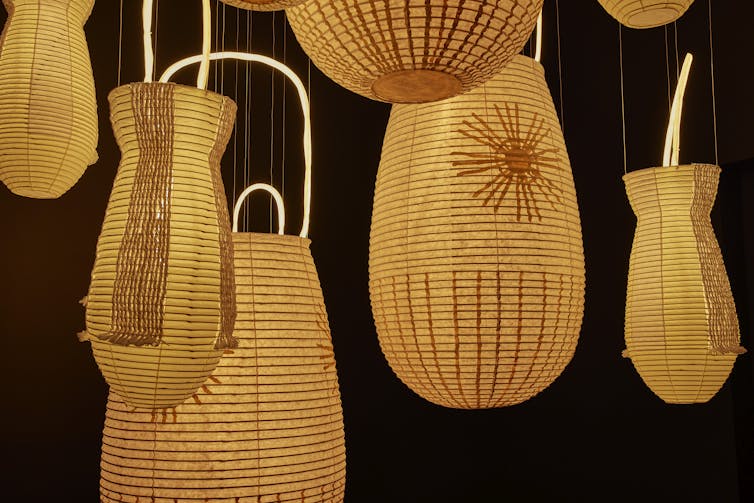
Emery’s work affected me more directly than I anticipated. I was prepared for an encounter with something approaching high kitsch with brightly coloured pom-poms forming the surface of this creature. For all its playfulness, there is something quite sombre in an encounter with this giant feline, shown like a specimen taken out of the wild, now beautified and preserved in a museum.
It’s possibly something to do with animal extinction and an interrogation of the relationship between us and non-human animals.
It will become a new icon for our time.
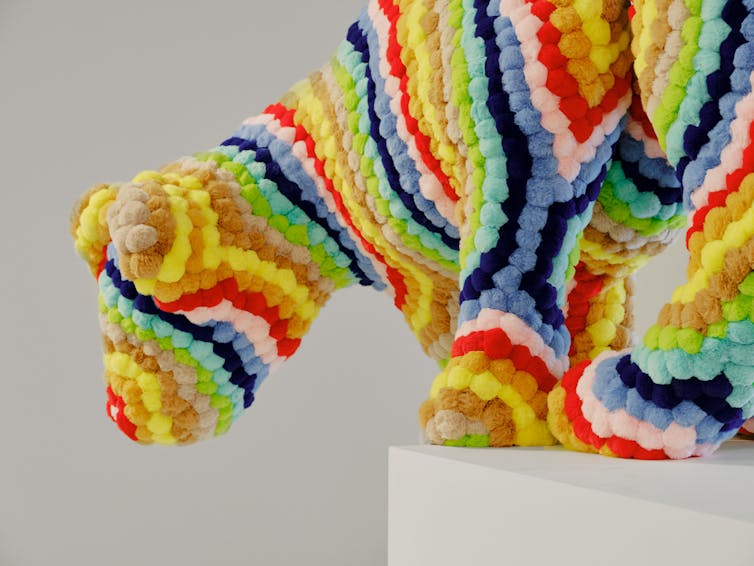
Art meets design
The distinction between arts and crafts dissolved many decades ago. Melbourne Now continues the process in dissolving the distinction between the visual arts as studio practice and functional design, fashion and applied photography.
The Design Wall that caused major ripples a decade ago has returned as a large-scale installation representing 23 Victorian design studios that over the past decade created new consumer products from guitars, pink cricket balls to electric motorbikes.
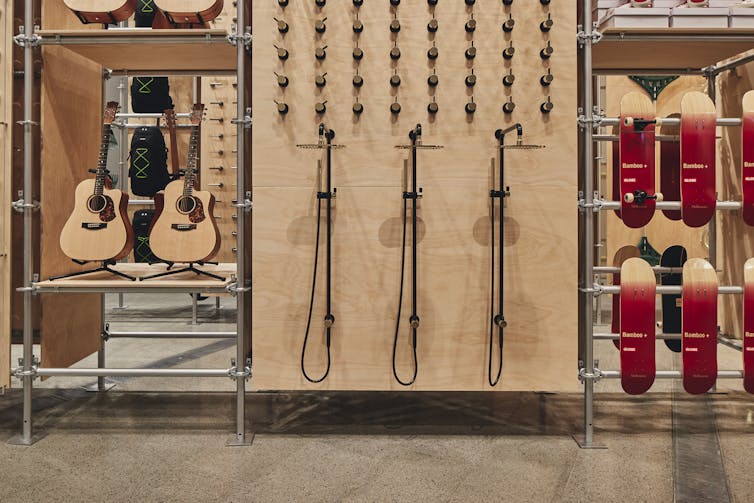
Fashion Now brings together about 20 local fashion designers including J’Aton Couture, Ngali and Kara Baker.
Jewellery Now carries out a similar exercise with contemporary jewellers spread over about 60 new or recent pieces that explore a variety of forms. They include incredible pieces by Inari Kiuru, Tessa Blazey, Kirsten Lyttle and Anke Kindle.
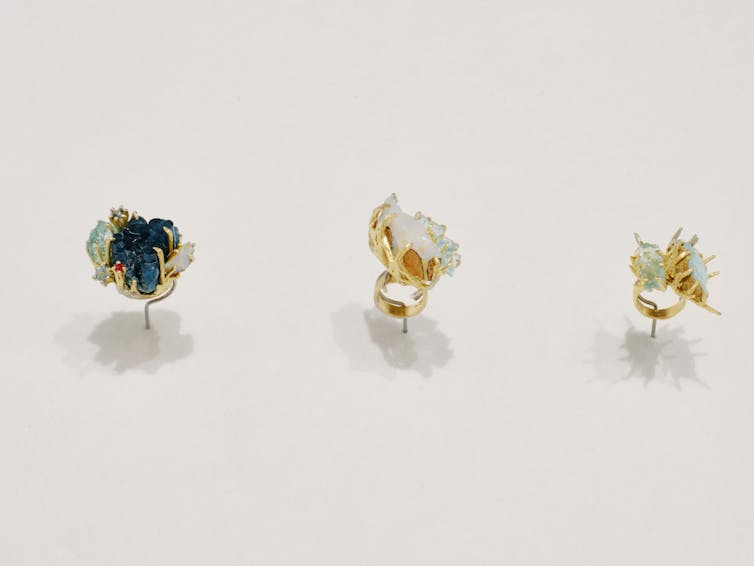
As so much in this exhibition, fundamental questions are raised concerning boundaries. What constitutes jewellery practice today and how is jewellery consumed by society?
Civic Architecture investigates five award-winning civic projects by Melbourne architects where different neighbourhoods have been transformed.
No House Style assembles some Melbourne-based furniture designers and architects who have departed from mainstream trends to create their own unique language.
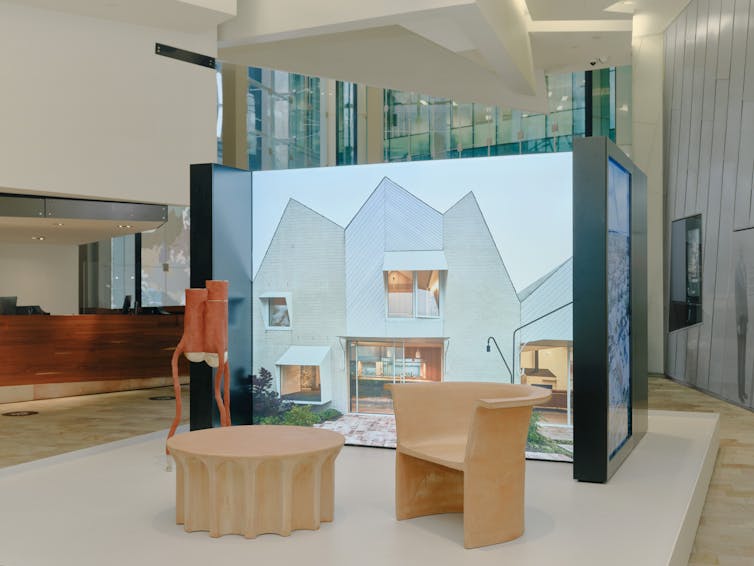
Vessels examines 15 artists who create containers from materials as varied as ceramics, fibre, mixed media and experimental biomaterials.
The art of photography is interrogated through Slippery Images, a glance at the work of 12 photographers. Printmaking is represented with a Print Portfolio by 12 printmakers plus the irrepressible Gracia and Louise and their bat installation.
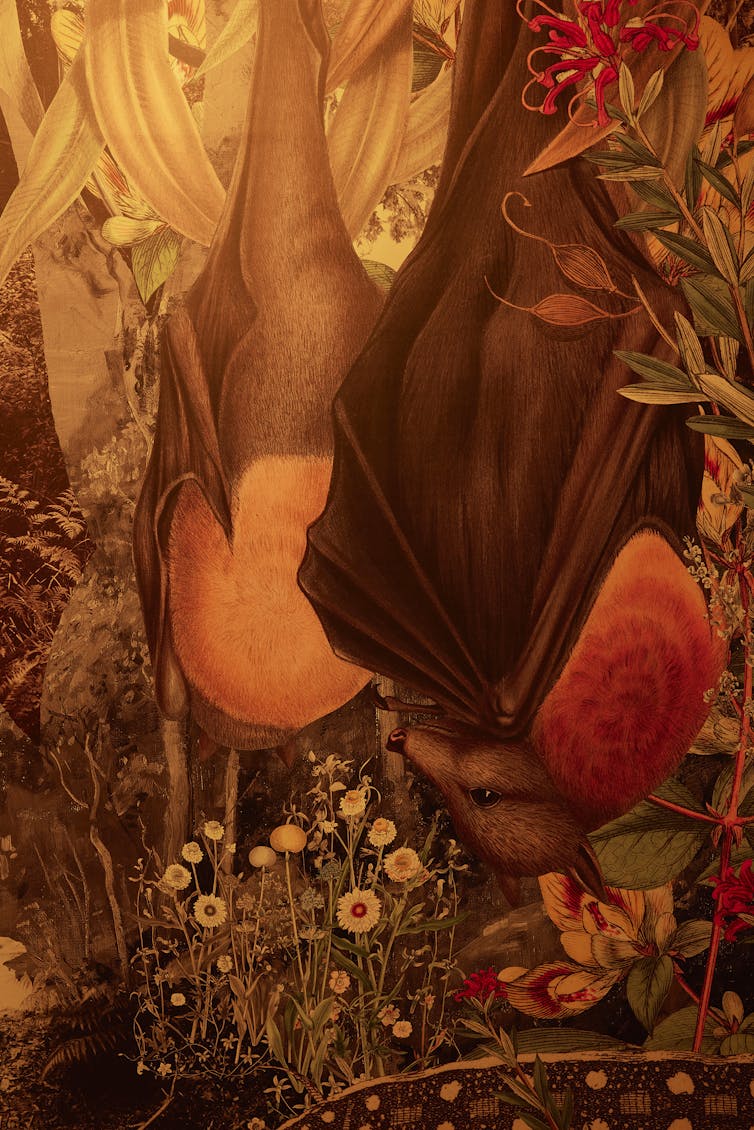
A memorable exhibition
Conceived as a snapshot of visual culture in Melbourne and Victoria, this exhibition is challenging, visually exciting and memorable.
If you find it a little bewildering, you can turn to Gee, an AI chatbot developed by Georgia Banks, who has been programmed as a target for your affections or lie down for Shaun Gladwell’s out-of-body experience.
Melbourne Now is at the The Ian Potter Centre: NGV Australia until August 20.![]()
Sasha Grishin, Adjunct Professor of Art History, Australian National University
This article is republished from The Conversation under a Creative Commons license.
Subscribe to support our independent and original journalism, photography, artwork and film.



























